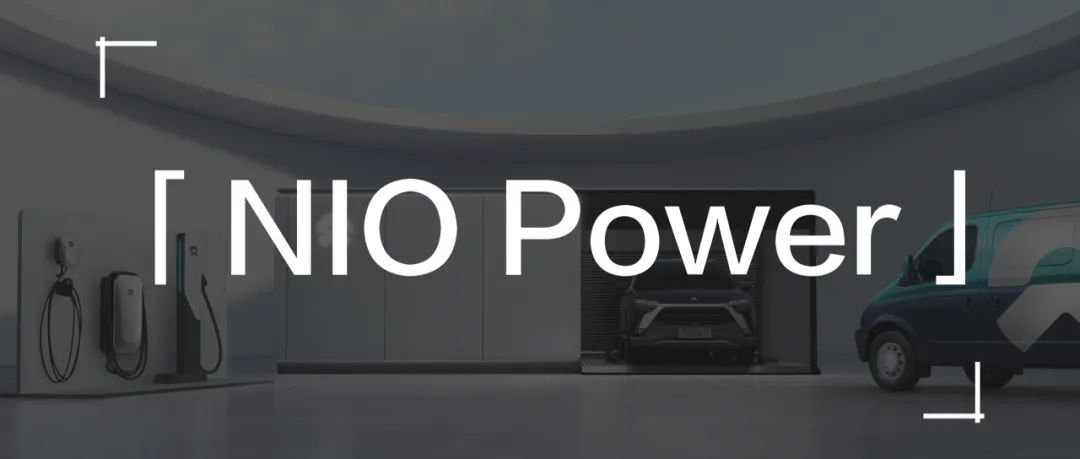Author: Yī piàn lǜ yè
In the NIO system, there are many business sectors that seem to serve only the whole-vehicle business, but their importance is no less than that of the whole-vehicle business.
The most important of these is NIO Power in the primary navigation bar on the NIO official website. Many people only understand NIO Power as part of the NIO supplement energy system brand, but building NIO Power has cost NIO the most effort.
Today, let’s talk about the construction and goals of NIO Power.
Full-Scene Electric Energy Service System
“Where gasoline cars can go, electric cars can also go.”
This is the vision of NIO Power – adding electricity is more convenient than adding gasoline. It was also a mocking phrase in 2018 when NIO was ridiculed.
If Li Bin dares to say it, users dare to try it.
In September 2018, a group of ES8 founders really drove their ES8s to play in Xinjiang.
The initial version of the ES8 is famous for its short battery life, with an NEDC range of only 355 kilometers. Even now, it’s a challenge, let alone then.
The owners wanted to see if NIO could deliver what they promised, and indeed they did. They used three fuel trucks carrying three fuel-charging cars and followed the users all the way to Xinjiang.
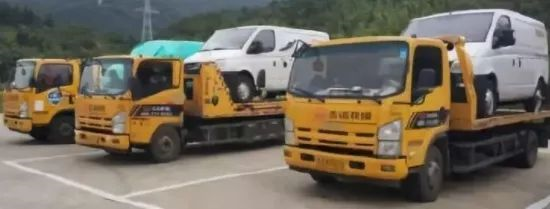
Still relying on gasoline.
At that point in 2018, it was more complicated for electric cars to recharge. Even the charging piles in first-tier cities were scarce, let alone the charging facilities in Xinjiang. NIO relied on refueling all the way and took the users throughout the Northwest, which was ridiculed throughout the whole network. Instead of eliminating range anxiety, it made things worse.
At the 2021 NIO Power Day, Qin Lihong mentioned this story again. Three years had passed, and the same road was now vastly different. Except for the route from Bayannao’er to Hami, which is located in the desert and is not easy to deploy charging facilities, it has to rely on mobile charging cars. On the coastal expressways, battery swapping can now cover the entire journey, and destination charging piles are also deployed in inland areas.
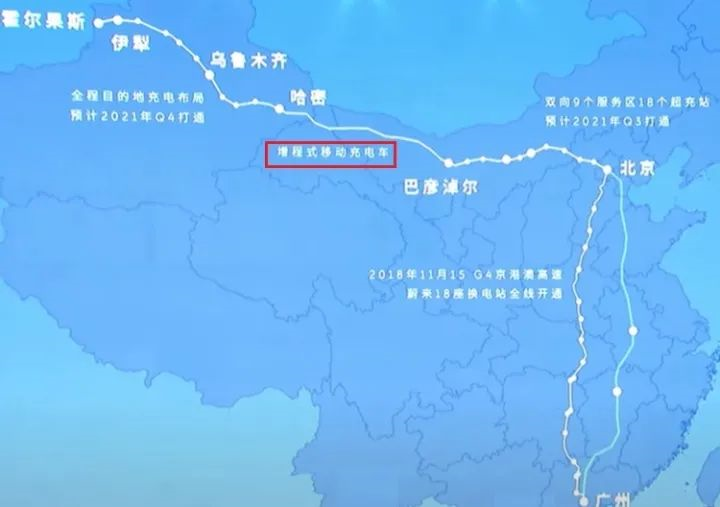
The mobile charging car, which was once the core asset for recharging on the go, has now taken a backseat, only deployed in areas with charging difficulties and emergency charging needs. In the past three years, NIO Power has gone from invisible to disregarded, to now incomprehensible, there might be no time left.
Now many car companies are investing in charging facilities, fearing being eliminated by the tides of the times. NIO Power is composed of mobile charging cars, charging piles, battery swapping stations, NIO specialists, and NIO clouds, providing users with a “chargeable, swappable, upgradeable” full-scene electric energy service system through vehicles, piles, stations, people, and the clouds. What is the “full-scene electric energy service system”?
This picture can explain everything.
As can be seen from the picture, the majority of the scenarios covered are related to travel and energy supply.
According to Qin Lihong, the owner of intercity travel mostly drives a distance between 200-400 kilometers, such as Shanghai-Hangzhou and Beijing-Tianjin, and only 0.5% of them are long-distance travel.
The most significant factor that explains the meaning of NIO Power is not NIO itself, but the policy.
According to the “Notice of the State Council Office on Issuing the Development Plan for the New Energy Vehicle Industry (2021-2035)”, it is written in the section “Accelerating the Construction of Charging and Swapping Infrastructure” that:
- Actively promote the charging service model of intelligent and orderly slow charging as the main mode and emergency fast charging as the supplementary mode in residential areas.
- Accelerate the formation of a moderately advanced public charging network for high-speed roads and urban-rural areas mainly based on fast charging and supplemented by slow charging.
- Encourage the application of the battery swapping mode.
The above will be discussed separately.
Promoting Home Charging
NIO is the carmaker that has been most actively promoting home charging.
Qin Lihong emphasized that “NIO’s home charging piles are the foundation of all our charging services”, and NIO has the highest home charging installation rate among carmakers.
At the 2021 NIO Power Day, NIO had already installed 75,360 home charging piles, and at that time (July 2021), there were about 120,000 car owners, with a home charging installation rate of 63%.
Looking at these numbers without knowledge of the low installation rate of home charging in China might not give a strong impression. As of June 2021, the total number of home charging piles in China was 1.024 million, and the number of pure electric vehicles was 4.93 million, according to the data released by the China Electric Vehicle Charging Infrastructure Promotion Alliance (EVCIPA) and the China Association of Automobile Manufacturers (CAAM), respectively.
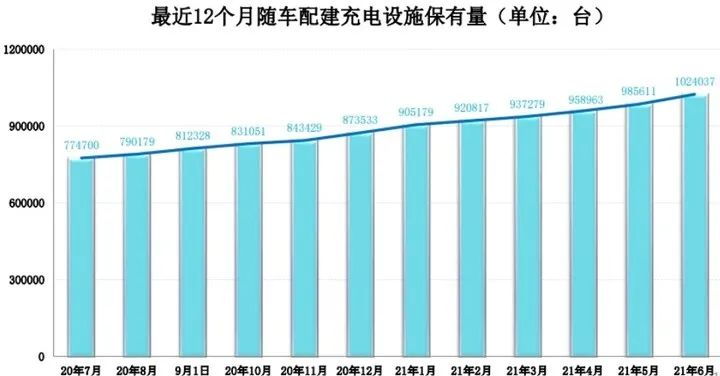
The average installation rate of home charging in China is only 21, which needs to be explained, and the actual installation rate of home charging may be higher than 21%.
Some car owners choose not to use carmakers’ charging piles and install it themselves, which is most common among Tesla owners because Tesla’s home charging is expensive to purchase and not worthwhile. These homemade piles are not recorded by EVCIPA.
There are two main reasons for not installing home charging: first, there is no fixed parking space; second, the property management does not cooperate.
As early as 2016, four ministries and commissions jointly issued the “Notice on Accelerating the Construction of Electric Vehicle Charging Infrastructure in Residential Areas” to make policy requirements for this issue:
Article 6:
Give full play to the role of property service enterprises.
In the process of installing charging infrastructure in residential areas, property service enterprises should cooperate with the owners or their commissioned construction units, provide relevant drawings and materials in a timely manner, actively cooperate and assist in site survey and construction.> Encourage property service enterprises to construct relatively centralized public charging facilities in public parking spaces and provide charging services based on user demand and authorization from the owners’ meeting.
As there are no fixed parking spaces, policies encourage the use of public parking spaces to build public charging stations. It sounds simple, but implementation is difficult. Many property management companies are hesitant to act, fearing the responsibility for firefighting and operation of public charging stations. The key issue is who is responsible in case of an accident, making it a complicated problem.
In light of this, the policy established by Chengdu is highly instructive.
Chengdu Model
According to the “Implementation Regulations for the Construction and Management of Residential Electric Vehicle Charging Facilities in Chengdu”, two types can be distinguished: Unified Construction and Management, and Self-Construction and Management.
- Unified Construction and Management
The local government guides the property management company, and promotes the charging operator (such as TELD) to carry out unified planning and construction based on the power consumption of the residential community and the needs of its inhabitants. Thus it is called “Unified Construction and Management”. According to the principle of “who owns, who is responsible”, the charging operator is responsible for the main body of the security management.
The problem is that charging operators’ service capabilities can vary widely. Some operators sign contracts with property management companies but fail to fulfill their management responsibilities. Damaged charging stations are often ignored, and only after repeated requests do they reluctantly send someone to repair them.
Moreover, some operators collude with property management companies and charge higher fees than general charging stations, losing the meaning of saving money by charging at home. During the operation, there may be other problems, such as what should be done if the community’s electric capacity is insufficient?
In the Chengdu model, the power grid company is responsible for capacity expansion, but the cost of expansion is not low. In some places, it is only possible with urban renewal. How should charging operators handle these issues?
TELD adjusts according to the real-time load of the community’s transformer.
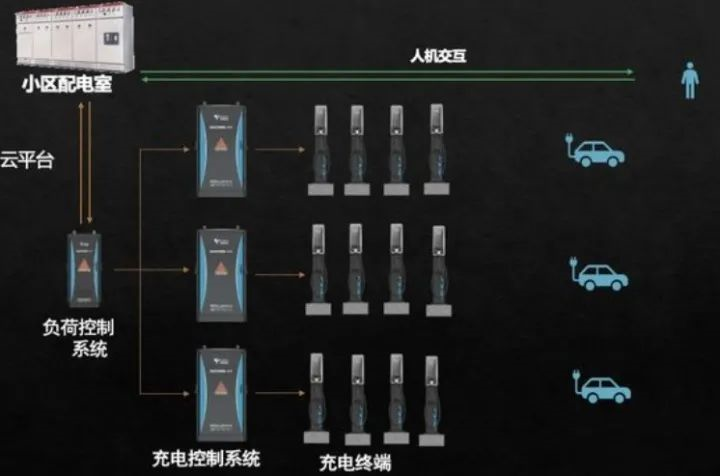
TELD’s approach is based on price-volume ratio, and pricing is based on the peak and valley of electricity usage. Many charging operators do it this way, but it doesn’t answer what to do if the charging demand exceeds the community’s electric capacity.
This situation does not occur.
TELD’s load control system can sense the real-time load of the community. Once it reaches the load warning line, the charging station will stop charging.
During peak electricity usage, community charging stations will not operate unless there is spare capacity on the load side. The charging operator takes the initiative to force trickle-charging in an orderly manner.
The biggest problem is probably when a gasoline vehicle occupies a charging station. Since it is a public parking space, the property belongs to all residents. At present, there is no way to manage gasoline vehicles parked in charging stations.
The most crude and simple way is to use a parking lock, which is also a no-brainer.
- Self-Construction and Management
The residents authorize an electric vehicle company or charging station construction unit to build, manage and bear the responsibility on their own. Therefore, it is called “Self-Construction and Management”.
An NIO owner shared their experience on the NIO app. Although it was not in Chengdu, but the model is shared.Mr. Zhang is the owner of a NIO ES8 Founder Edition and is also a representative of the community’s homeowners association (HOA). After the expiration of the old property contract, he organized an HOA meeting to remove the developer’s property management company and hired a new one to manage the community. However, there are several prerequisites:
- First, the community must have its own HOA (which is considered “other organizations” in legal terms and has the capacity for civil litigation);
- Second, since the HOA is a “three-no” organization (no funds, no salaries, no office space), it requires its representatives to invest time and energy in communicating with other homeowners. The person who organizes the HOA meeting must have prestige and the ability to gain other homeowners’ trust to succeed;
- Third, the property fees must be transferred to the property management company through the HOA meeting, with financial pressure to prevent the property management company from being passive;
- Fourth, the parking spaces belong to all homeowners and are public parking spaces. The profits from public facilities belong to all homeowners. Larger communities are more challenging to promote because the homeowners do not know each other and have low trust. Smaller communities are more likely to succeed.
In the past, the third-party charging poles installed by the old property management company had low maintenance efficiency and poor experience. After the old property management company was removed, these charging poles were removed. However, the development of electric vehicles is unstoppable, and it is necessary to have a charging station in the community. Therefore, Mr. Zhang recommended NIO’s charging service and became NIO’s charging partner.
Through NIO’s intelligent interconnect operation platform, equipment maintenance and management is provided, and through the charging partner’s WeChat mini-program, the site revenue, the status of the charging poles, and the charging price can be monitored anytime, anywhere.
Of course, there are also difficulties because the funding for the HOA meeting is contributed by all homeowners, so why would gasoline vehicle owners agree? To establish consensus, the unique advantages of the charging partner are used to persuade other homeowners.
Firstly, the revenue generated by charging poles, except for electricity costs, is summarized as HOA funds, which becomes the common property of all homeowners, and NIO will not make any deductions.
Secondly, NIO is responsible for the operation and maintenance of the charging station, the product experience and service are excellent, and the financial flow is secure, transparent, and maintenance can be performed quickly.
As for gasoline vehicles occupying parking spaces, electric vehicle owners must unite and “power out of love.” Mr. Zhang’s approach is to unite other electric vehicle owners in the community, establish a WeChat group, and homeowners in the group will reserve charging time. If other homeowners return to the community, they will occupy the parking spaces for homeowners who need charging, and move the cars back when they come back. After a period of operation and coordination by the property management company, everyone gradually developed the habit of “gasoline vehicles in gasoline parking spaces, electric vehicles in electric parking spaces.”
The “homeowners create and share charging” model is strongly advocated by Mr. Shen Fei.
However, it must be acknowledged that the “self-built and self-managed” model is not easy to succeed and requires promoters to have efficient execution and selflessness to achieve success.
The Chengdu model is mainly based on “built and managed uniformly” with “self-built and self-managed” as a supplement, hoping that the charging station in the community can be built as needed.
One-stop exclusive pole installation serviceThe shared parking spaces in the community can be jointly built and managed or self-built and self-managed to solve the problem of charging piles. NIO provides one-stop installation services for home charging piles.
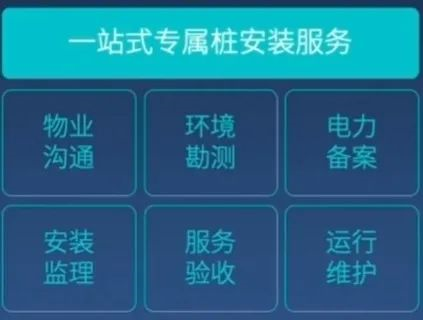
The biggest difference between NIO and other car companies is the communication with property management, which is the most difficult part of installing home charging piles.
Under the strong policy promotion in China, as long as the community’s power capacity is sufficient, the power supply bureau will allow the installation of electricity meters. NIO will handle the follow-up services, and the most energy-consuming thing for car owners is to get the property management’s approval.
Without the consent letter from property management, the power supply bureau cannot install electricity meters, which means there is no follow-up. Property management usually cites fire safety as the most common reason, followed by insufficient power capacity and other reasons to prevent car owners from installing home charging piles.
NIO will help car owners provide documents. Insufficient power capacity is not determined by the property management but by the power supply bureau. According to the “Residential Community Power Configuration” requirement for new small communities, the power demand for charging power of property rights parking spaces should be reserved 8kW load. Except for the cases where the local community’s power capacity is particularly tense after 2018, there should not be insufficient power capacity problems for installing home charging piles.
In old communities, there may be power capacity problems. The first come, first served policy applies based on the principle of first application and first occupation. As for fire safety issues, NIO will communicate with property management together with car owners. Now, home charging piles of electric vehicle companies meet safety standards. Moreover, if there are any problems with the home charging piles of car companies, the responsibility lies with the car companies and has nothing to do with the property management.
If property management still disagrees, it depends on whether the owner is willing to file a lawsuit. NIO will do its best to provide help. The NIO app provides the first case of home charging pile lawsuit in Hebei Province for reference.
There are three key points of the litigation:
First, confirm the cause of action.
- Use the “Property Service Contract” signed as a breakthrough and not the “removal of obstacles” as a reason. Read the “Contract” carefully and find “Items not provided in the contract shall be implemented in accordance with relevant laws, regulations, and policies of the People’s Republic of China.”
Second, state the current situation.
- Explain the facts of the lack of “proof” issued by the property management and the inability to use normally. Summarize the focal points of the dispute in brief.
Third, specify the requirements.
- Focus on installing home charging piles. Do not place the emphasis on charging power, and avoid losing the lawsuit by arguing that “public charging piles can supplement energy, which also conforms to new energy policies.”
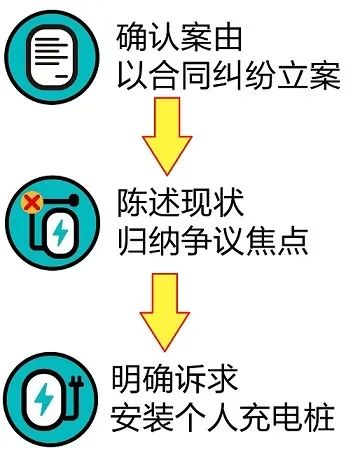
China’s policies encourage home charging, and the success rate of suing is high, as long as it complies with the legal conditions. However, it can be seen that there is still a huge gap in implementing policies. Lawsuits are time-consuming and laborious, and few car owners will go this far.
In response to community charging, Shen Fei also provides two sharing methods:
First, share private piles. The home charging piles of NIO can be opened to authorized car owners for charging through the app; However, it is difficult to handle when there are disputes.## Two, Shared Home Charging Stations
The shared home charging stations are to be installed below the electric meter to distribute electricity to other NIO vehicle owners who do not use their own home charging station often enough for it to be feasible.
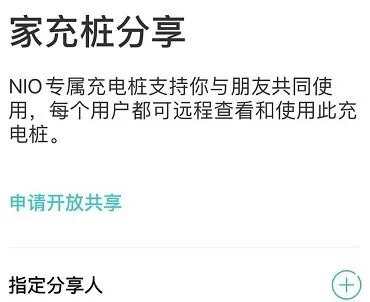
If there is no neighborhood charging station available, NIO provides the ultimate solution – the one-click charge.
Home Charging Stations and V2G
Although NIO is best known for its swap stations, Qin Lihong mentioned in the 2021 NIO Power Day conference that out of the 3205 NIOs, all of the supplemental charging was done using home charging stations. It is the best experience for electric vehicle owners to be able to charge conveniently at home, without wasting additional time on charging, and customer satisfaction is the best service.
Therefore, NIO is vigorously promoting home charging stations.
In the context of China’s dual-carbon goals, electric vehicles are an important energy sponge for the grid. NIO has partnered deeply with the State Grid Corporation of China to explore the commercial feasibility of Vehicle-to-Grid (V2G) technology. Home charging stations are essential infrastructure for this development.
Every winter NIO holds a “clean energy usage” home charging activity. From winter until the end of April each year, charging between 12:30 a.m. and 7 a.m. will earn 1 NIO Point per kWh, equivalent to 0.1 RMB. In addition, the top 10 individuals for the month receive an additional 888 points, and the top individual receives 1888 points.
This activity reduces lost wind power in winter, promotes clean energy use, and allows new energy vehicles to recharge using renewable energy.
At present, this is only a pilot program, restricted to vehicle owners in Beijing-Tianjin-Hebei region, but is expected to be expanded to provide benefits to more regions.
The State Grid Corporation of China aims to achieve: adjustable charging, behavior guidance, predictable behavior, and adjustable load.
NIO is currently partnering with the State Grid Corporation of China to carry out new business projects that require home charging stations, from orderly charging to V2G.
Accelerating the Establishment of Public Charging and Battery Swap Networks
After the release of the second-generation battery swap station in April 2021, the establishment of swap stations entered a period of rapid development. Within three years from the launch of the first generation swap station in 2018, a total of 200 stations were established. Within just six months of the second generation launch, 400 stations were established, twice the total for the past three years.
As of January 21, 2022, NIO has established a total of 800 battery swap stations.Li Bin opened the Cowshed Mid-Autumn Festival in Changsha and mentioned the deployment plan for future battery swapping stations. “For urban battery swapping stations, we are accelerating their deployment. Apart from special peak hours, the queue phenomenon has already become rare. Many users are dissatisfied and have left messages on the app, saying ‘Brother Bin, we think there are not enough high-speed battery swapping stations now.’ Indeed, high-speed battery swapping stations are especially good for long-distance or intercity travel experience for electric vehicles, and can achieve replenishment speeds similar to gasoline vehicles. High-speed battery swapping has always been one of our goals. The main content to be released this time is that the high-speed battery swapping network’s work to be completed before the Spring Festival (2022).”
Five Vertical and Three Horizontal, Four Major Metropolitan Areas
Five Vertical:
- G1 Jingha Expressway
- G2 Jinghu Expressway
- G4 Jinggang’ao Expressway
- G5 Jingkun Expressway
- G15 Shenhai Expressway
Three Horizontal:
- G30 Lianhuo Expressway
- G50 Huyu Expressway
- G60 Hukun Expressway
Four Major Metropolitan Areas: Beijing-Tianjin-Hebei, Yangtze River Delta, Greater Bay Area, Chengdu-Chongqing.
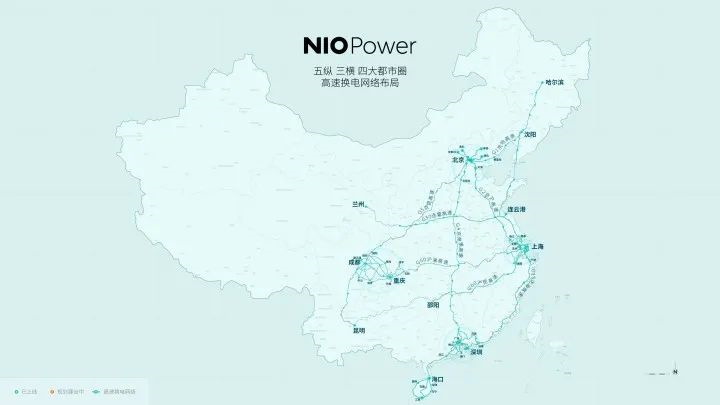
- G4 Jinggang’ao Expressway and G2 Jinghu Expressway
These two routes were the early completed high-speed battery swapping routes of NIO, which were built in 2018.
G4 starts from Beijing and goes south through Hebei, Henan, Hubei, Hunan, Guangdong, and Hong Kong to the endpoint Macao, which is a major north-south transportation artery connecting North China, Central China and South China.
G2 starts from Beijing and goes south through Tianjin, Hebei, Shandong, and Jiangsu to the endpoint Shanghai, which is the transportation artery of the Beijing-Shanghai metropolitan area. As the two routes were built in the early stage, all the stations are first-generation stations.
With the rapid growth of NIO’s sales, there is no room for further development. Therefore, second-generation stations were added at some busy traffic nodes to reduce the distance between stations and improve the battery swapping experience.
- G1 Jingha Expressway and G5 Jingkun Expressway
These two routes are located in the north and south respectively and centered on Beijing, connecting Northeast China to Southwest China.
G1 starts from Beijing and goes northeast through Tianjin, Hebei, Liaoning, and Geelyn to the endpoint Harbin, the capital of Heilongjiang Province, which is the main transportation route from North to Northeast China.
G5 starts from Beijing and goes southwest through Hebei, Shanxi, Shaanxi, and Sichuan to the endpoint Kunming, the capital of Yunnan Province, which connects North China with Southwest China. The expressway passes through mountainous areas and is also known as the “Ladder to the Sky Expressway”.
G1 was fully operational in September 2021, but many battery swapping stations in Northeast China are not within the service area and need to get off the highway, which greatly reduces their convenience. Especially in Liaoning Province, many service areas don’t even have charging piles, let alone battery swapping stations. Northeast China’s charging and swapping infrastructure still has a long way to go.
Only some parts of G5 have completed the construction of battery swapping stations on expressways in Sichuan. Other stations will be built and connected before the Spring Festival. As G5 is very long, there will be additional station deployments in the future.
- G15 Shenhai Expressway# G15 Great Wall Highway
G15 starts from Shenyang, Liaoning Province in the north, and goes south through Shandong, Jiangsu, Shanghai, Zhejiang, Fujian, Guangdong, to the final destination Haikou, Hainan Province.
G15 connects Northeast, North, Central and South China, and it is the longest highway in terms of distance that runs through both North and South China. There are two ferry crossings needed along the way, from Liaoning to Shandong, and from Guangdong to Hainan.
Therefore, it is planned to build the highway in North and South sections with the most charging stations among all highways. This is the layout of the five vertical highways.
G30 Lianhuo Highway
G30 starts from Lianyungang, Jiangsu Province in the east, and goes west through Anhui, Henan, Shaanxi, and Gansu to the final destination, Horgos, Xinjiang. G30 is the longest highway in China. NIO has currently opened up routes between Henan and Baoji, Shaanxi, and will open up routes between Jiangsu and Baoji, Shaanxi, before the Spring Festival.
By 2022, the charging station plan only opens up to Lanzhou, the capital of Gansu Province. The charging network from Lanzhou to Horgos will focus on supercharging stations with fast charging stations as a supplement.
G50 Shanghai-Chongqing Highway
G50 starts from Shanghai and goes west through Jiangsu, Zhejiang, Anhui, and Hubei to the final destination, Chongqing.
G50 runs through the middle and lower reaches of the Yangtze River, connecting transportation along the Yangtze River. There are currently only a few scattered charging stations, and it is expected to be fully opened before the Spring Festival.
G60 Shanghai-Kunming Highway
G60 starts from Shanghai and goes west through Zhejiang, Jiangxi, Hunan, and Guizhou to the final destination, Kunming, the capital of Yunnan Province.
G60 connects Central and Southwest China, and has now opened up routes from Shanghai to Shangrao, Jiangxi. It will open up routes to Hunan before the Spring Festival and complete the entire highway by the end of 2022, which is the layout of the three horizontal highways.
Four Major Urban Clusters
- North China: Beijing-Tianjin-Hebei – Highways centered around Beijing radiating towards Tianjin and core cities in Hebei Province.
- Central China: Yangtze River Delta – Ring highways centered around Suzhou covering Shanghai, Jiangsu, and northern Zhejiang Province.
- South China: Greater Bay Area – Highways connecting Guangzhou and Shenzhen spreading across the Pearl River Delta urban agglomeration in Guangdong Province.
- Southwest China: Chengdu-Chongqing – Ring highways connecting two urban clusters centered around Chengdu and Chongqing.
The layout of the five vertical highways, three horizontal highways, and four major urban clusters is mainly based on highways with charging as the focus. NIO also has a charging and swapping network plan for urban and scenic areas.
Power Up Plan
The Power Up Plan is a further expansion of the Energy Replenishment Plan for NIO’s Power Partners.
Power Partners are NIO’s commercial partners that help to expand its charging and swapping network rapidly. Partners can provide sites and advantages in power supply, or invest directly. They can even provide connections to facilitate cooperation. As mentioned earlier, Mr. Zhang is a Power Partner of NIO, responsible for connecting NIO with the property management of residential districts to realize sharing of charging facilities.
The Power Up Plan is jointly implemented by NIO and Power Partners, which deploys destination charging stations in popular tourist, business, and leisure destinations across the country to form a convenient fast charging network covering the entire country.To promote the development of charging, NIO offers a subsidy of 100 million yuan. As long as the destination charging station does not charge a service fee for NIO car owners, NIO will subsidize each station by 1,000 yuan per year, for a period of three years.
If you do not have the conditions to become a Power Up Partner, as long as you successfully recommend friends and family to install destination chargers, the referrer can get some points or charging fees.
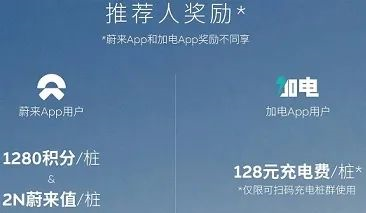
Currently, many tourist routes have been opened, such as the Sichuan-Tibet-Qianghuang line, the Duku Highway, the Taihu Lake Ring Road, and the Geelyn Changbai Mountain and Hexi Corridor.
Do you remember the three board trucks carrying three fuel charging cars at the beginning? At first, a Tesla owner organized a pure electric Everest trip, and two of his friends were Tesla and NIO owners, who boasted how good NIO was to him.
He made a promise to the two friends, “If it is as good as you said, I will buy a NIO and take you to Xinjiang.”
After test-driving the NIO, he found many minor problems, but when he drove back to his Tesla, he felt that the comfort and sound insulation of his Tesla were not as good as NIO’s, so he soon ordered an ES8 Founder’s Edition. Since he bought it, he must fulfill his promise and drove NIO on G7 expressway to run a trip in Xinjiang in September 2018.
This is the owner’s trip to Xinjiang.
He recalled afterwards:
“Car owners are quite happy, but it was a big blow to NIO Power at the time. I love traveling, but after that Xinjiang trip, he was determined to go to Tibet again and wanted to drive NIO there, but he will definitely not bring NIO’s nanny car.”
This owner wasn’t just talking. He completed China’s first fully-equipped fast-charging network along the Sichuan-Tibet line.
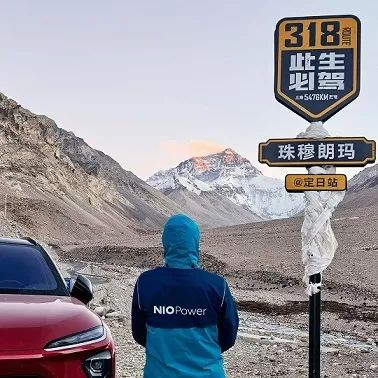
This owner’s NIO APP account is “Doctor Jin”, who is also the first Power Up Partner of the 318 Sichuan-Tibet Highway in NIO’s Power Up Plan tourism line.
He summed up this event as a journey to the West, with long and difficult roads, difficult weather, difficult site selection, difficult communication, and difficult transportation.
But he is not alone in the fight!
Along the way, many NIO owners helped him, which made him feel warm. Some owners accompanied him throughout the journey and worked together to build charging stations; some actively helped him choose sites; some even provided venues.
“Incurred costs, consider it as a vow, and I still have feelings for NIO.”
Together with NIO owners, NIO is practicing a goal: “Wherever fuel cars can go, electric cars can also go.”
This article is a translation by ChatGPT of a Chinese report from 42HOW. If you have any questions about it, please email bd@42how.com.
